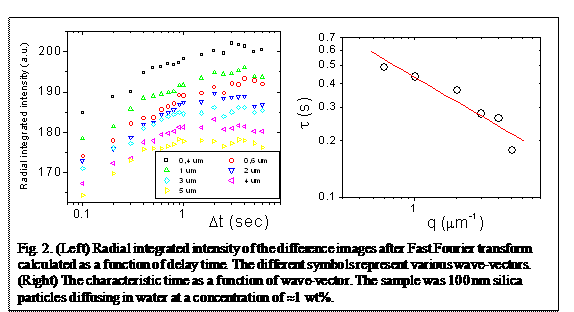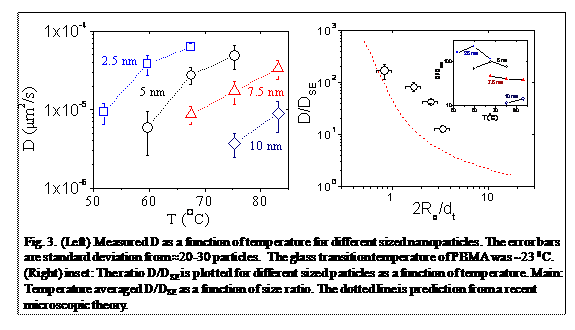Reports: ND1051694-ND10: Temperature-Tunable and Switchable Colloidal Interactions in Multi-Component Fluids
Ashis Mukhopadhyay, Wayne State University
We also started a new method of image analysis called differential dynamic microscopy (DDM). We needed it to analyze image because it can be used with less interference from background scattering, which happens near the critical point. The idea is to calculate the difference between frames in video files at various time differences and then perform Fourier transforms of the difference images. The statistical analysis of the data is used to determine Brownian motion of the particles in the wave-vector space (Fig. 2). A new graduate student has been recruited, who is currently writing a CUDA code to analyze the large amount of data set that is generated in this way.
In parallel, the support from the PRF grant had helped us to pursue other experiments and continue students training and research. A total of three papers have been submitted recently and these are at various stages of the review process. In all cases, the graduate students are the first author of the paper. In one manuscript, we measured the dynamics of gold nanoparticles (NPs) within an entangled liquid of poly (n-butyl methacrylate) (PBMA) above the glass transition temperature (Tg). The paper was originally submitted at Physical Review Letters, but was unfortunately turned down. It is currently under review at Macromolecules. The experiments were performed by using a modified version of fluctuation correlation spectroscopy (FCS), which measured the translational diffusion (D) of the isolated NPs as a function of their size (2Ro=5-20 nm) and temperature (T). We probed the most interesting but sparsely investigated length regime where the particle size/tube diameter (dt) ratio ranges between ~1-4. This allowed us to put into direct test recently developed theories and simulations (Fig. 3). By measuring the bulk viscosity of the melt, the ratio D/DSE was determined, where DSE is the continuum prediction from Stokes-Einstein (SE) relation. Our results indicate gradual recovery to SE behavior and full coupling to entanglement relaxation would require 2Ro » 7-10dt.
A second manuscript has also been submitted in Macromolecules, where we used novel multiphoton fluctuation correlation spectroscopy (MP-FCS) technique to investigate the translation and rotational diffusion of gold nanorods (AuNRs) in polyethylene glycol (PEG) solutions of varying volume fraction and molecular weights (Fig. 4). The motivation for this study was to test various polymer theories and simulations, especially the effects of hydrodynamic forces, polymer segmental motion, and topological constraints on the NR transport properties. We determined the nanoviscosity experienced by the NRs and compared it with the theoretical studies of nanosphere diffusion in semidilute and entangled polymer solutions. We showed that hydrodynamics completely breaks down at higher volume fraction within entangled polymer and the non-hydrodynamic friction dominates the transport of the nanoparticles.
The third manuscript, submitted at Journal of Physical Chemistry C, studied the interaction of a biological molecule, bovine serum albumin (BSA) with the cetyltrimethylammonium bromide (CTAB) stabilized gold nanorods. The measured diffusion coefficients were analyzed to determine the change of the hydrodynamic size of the particles due to the adsorption of protein (Fig. 5). We found that the saturation coverage is less than one monolayer of protein on the top of AuNRs at a BSA concentration of »1 mM. The adsorption isotherms were compared with the anti-cooperative and Langmuir binding models to quantify BSA-NR association. Our results can be best interpreted in terms of hydrophobic interaction between the imperfect CTAB coatings and the buried hydrophobic residues of the protein, which results in a loss of protein native conformation. The results were compared with previous studies of nanosphere interaction with BSA molecules.
















